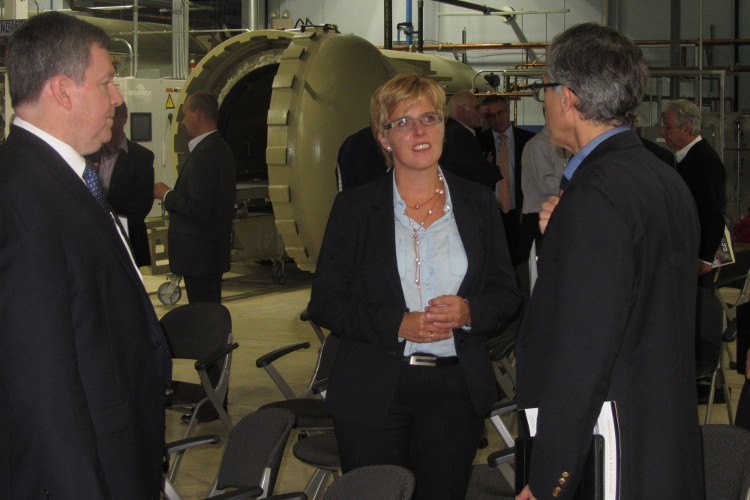Long Island’s potential to take the lead in producing offshore wind power on the East Coast drew 19 Danish companies specializing in this fast-growing renewable energy field to spend a day touring local facilities and meeting local officials.
The day-long visit on Nov. 12 was organized by the ministry of foreign affairs of Denmark and hosted by the Long Island Association and the Long Island Forum for Technology. This Danish trade delegation included manufacturers of turbines and wind farm components, businesses that build foundations and oversee installations, as well as handle logistics and transport materials.
“Long Island is poised to be a leader in the U.S. offshore wind industry,” said Kevin Law, president and chief executive officer of the LIA. “The Danish delegation’s visit is evidence that our energy challenges are great economic development opportunities.” Investment could mean hundreds, if not thousands, of good paying local jobs, he added.
Among those on hand at the Composite Prototyping Center, a state-of-the-art manufacturing facility in Plainview, which was the tour’s last stop before dinner, were American representatives from Deepwater Wind, the offshore wind developer that intends to supply LI with more than 200 megawatts from its proposed Deepwater ONE offshore wind farm.
“We’re in construction right now on the first offshore wind farm in the U.S., off the coast of Rhode Island,” said Clinton Plummer, vice president of development for Deepwater Wind, whose company motto is “clean energy is just over the horizon.”
“We’ve already taken delivery of 15 blades from a company called LM Wind Power, which is here today,” Plummer explained. “LM is a great example of the promise that offshore wind has for Long Island. They’ve got a dozen manufacturing facilities around the world and they go to those places where there’s demand for their product.”
He explained that the Danish companies on the tour are part of “the supply chain” for wind power developers like Deepwater. One outcome of the trade delegation visit, he said, is that the companies based in Denmark will be able to “form partnerships or find opportunities” to invest with local companies on the Island and build new facilities here.
“Long Island is a great place for offshore wind development because of the high energy prices, dense coastal population, and real difficulty in building anything else here,” Plummer said. “We see that offshore wind can be the most cost-effective new source of energy for this Island.
“This is one of the industries in which Long Island has a competitive advantage,” he added.
Deepwater is building five turbines at the Block Island Wind Farm, but it’s such a “small project,” Plummer said, that Deepwater can’t afford to build local supply ports and fabricating facilities. But Deepwater ONE, the big project to be built 30 miles off Montauk, is so big that it’s “at a scale where we can afford to invest and build the fabricating facilities here.”
In July 2013, Deepwater went “11 rounds against two other companies,” he explained and acquired the lease for the 256-square-mile offshore site. Soon, they’ll be open for business, and that’s one reason he was in Plainview to meet with the Danish delegation.
Known as the world’s “wind power hub,” Denmark has been at the forefront of this clean technology, with Danish companies reportedly producing more than 90 percent of the world’s offshore wind installations. The country recently announced that it intends to be free of its dependence on fossil fuels by 2050.
As for Long Island, Claus Anderson, the consulate general of Denmark, said, “We see a huge potential here.” He mentioned that just in the last decade the United States has made huge strides in relying on renewable energy, such as offshore wind, and it is catching up fast.
Bill Wahlig, executive director of the Long Island Forum for Technology, gave a brief geography lesson to the visiting delegation, showing them on a map where their tour had already taken them that day. Their first stop was the Enterprise Park at Calverton (EPCAL), then they went to see Stony Brook University’s Advanced Energy Research and Technology Center. They then amet with Nassau County Executive Ed Mangano and Suffolk County Executive Steve Bellone at the LIA office in Melville.
LI’s “robust economy” surpasses that of 20 states, Wahlig explained, adding that they hope to maintain that advantage. With that thought in mind, he mentioned Brookhaven National Laboratory for its work “on the origins of the universe,” Cold Spring Harbor Laboratory for its pioneering genomics research, and threw in a plug for North Shore-LIJ Health System for its medical advances. But when he showed a slide of the Earth taken from the surface of the moon in 1969 thanks to the lunar module built on Long Island by Grumman’s engineers that seemed to impress the visitors the most.
“I am confident that your partnership and the potential that we have with the offshore wind industry will produce similar great results,” he said. “And hopefully really propel mankind to reach a sustainable future.”
Dorte Kamper, LM Wind Power’s commercial director for the Americas, recounted how quickly the market has grown. The largest manufacturer of wind turbine blades in the world, LM Wind Power has now made more than 160,000 blades since 1978, creating the capacity to replace approximately 110 million tons of carbon dioxide annually generated from fossil fuels. Though her company is still headquartered in Denmark, they’ve built manufacturing facilities on four continents, including one in Arkansas, another in Quebec, and a new plant that just opened in Brazil. She presented a video clip showing the construction of the “world’s largest wind turbine blade,” weighing 26 tons, made out of polyester resin blend with a special coating that protects against salt erosion, perfect for an offshore facility.
“I really like Long Island,” Kamper later told the Press, admitting that she’d been here “many times” already. Asked if this promised partnership to build offshore wind farms has a chance, she replied, “I hope so! I certainly hope so!” Deepwater is already planning to use LM’s blades for its Block Island facility. “I hope the rest will happen!” she said.



























